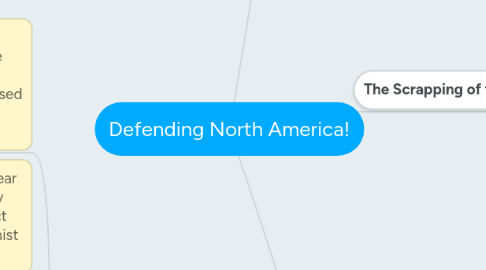Defending North America!
by Elaina Gofredo

1. Canada's Acceptance of Nuclear Weapons in 1963
1.1. The Canadian government responded to a NATO request that 1 Canadian Air Division be given a nuclear strike role in Europe. Canada initially accepted the assignment and purchased CF-104 fighters specially adapted to carry nuclear munitions.
1.2. Many believed that nuclear weapons were extremely important to help protect Canada against communist aggression.
1.3. A lot of business leaders believed that Diefenbaker's anti-Americanism would hurt trade and investment from the USA.
1.4. The Conservative government bought Bomarc missiles from the USA during the 1959 to replace the Avro Arrow. In order for them to be effective, they needed to carry nuclear warheads.
1.5. Very hypocritical to urge the United Nations to work for disarmament while accepting nuclear weapons.
1.6. Many feared that this would result in global suicide.
1.7. By giving up the Avro project, it was destroying Canadian innovation but helping the American's by supporting their country and industry.
1.8. Nuclear power and weapons are huge safety risks. If something were to go wrong, thousands and thousands of people would be negatively impacted.
2. Canada's Role in the Cuban Missile Crisis
2.1. Canada would have to accept nuclear weapons in order to be a full effective partner in NORAD and NATO.
2.2. Canada should always fight against communist threats to stay free and democratic.
2.3. Troops were eventually put on alert, however, only after the damage on Canada-USA relations was done.
2.4. The nuclear missiles located on Cuban basses were an immediate threat to the security of North America.
2.5. The Canadian government did not put its NORAD forces on alert and did not let US planes with atomic weapons land at Canadian bases, as it did not want to get involved.
2.6. P.M. Diefenbaker was reluctant to have Canada drawn into a major conflict that mostly concerned the USA.
2.7. Cuba was only trying to defend itself from the dominance of American power. It was trying to gain its freedom back from the US. This was an issue strictly between the US and Cuba and it was not Canada's problem to deal with. Canada should not be involved just because its ally was.
2.8. The Cuban Missile crisis was largely caused by the US's poor management of its foreign policy. Canada should not have been involved in a problem so mainly established in US foreign policy. This would set back all of the steps that Canada has taken to gain a nation identity and to become more independent of other countries. Canada's priorities should have been to protect its independence and interests.
3. The Scrapping of the Avro Arrow
3.1. There were very few orders from the new government, under the leadership of P.M. John Diefenbaker, as he did not support the idea.
3.2. The planes manufacturing company "A.V. Row" was extremely disorganized and was doomed to exceed costs.
3.3. Faster and more advanced than any other comparable aircraft, the Arrow was designed to carry air-to-air nuclear-tipped missiles to destroy Soviet bomb attacks over the Canadian North.
3.4. The Avro Arrow was the most advanced aircraft in the world at that time; however, upon further research, it was far from perfect. It was in the infancy of its flight testing and not as extraordinary as many believed. The Arrow was incompatible with North American Air Defense's (NORAD) keystone computer system, and did not compare to air crafts invented at a later date. Critics also believed that the A.V. Row Company was a "ramshackle, disorganized company" (Bliss, 1994).
3.5. Doubts mounted as the government's order shrank to 100 and unit costs rose. In October 1958, to cut costs, the new Conservative government terminated Canadian fire-control and missile development
3.6. After export efforts failed again, the project was cancelled and on February 20th, 1959. A.V. Roe bitterly fired 14,000 employees; the government ordered all plans and prototypes destroyed; and many Canadians bemoaned the devastation of Canada's aircraft industry
3.7. The Canadian Government spent millions on the development on the Arrow. Cancelling the project meant throwing away all the money that had already been spent on the development. The Government also spent more money after cancelling it on fewer used inferior aircrafts that were rejected as well. Purchasing second hand US fighters and deploying US nuclear missiles resulted in Canada needing to pay twice: once for the development of the Arrow and a second for buying replacements.
3.8. As flight testing ensued and initial production expectations ramped up, the Arrow ran into strategic problems. The first issue pitted the Arrow against the surface-to-air missile (SAM). The appearance of effective SAM's made life difficult to impossible for high-flying bombers, meaning that they had to change tactics (either flying low and slow, or using long-range cruise missiles) or disappear.


